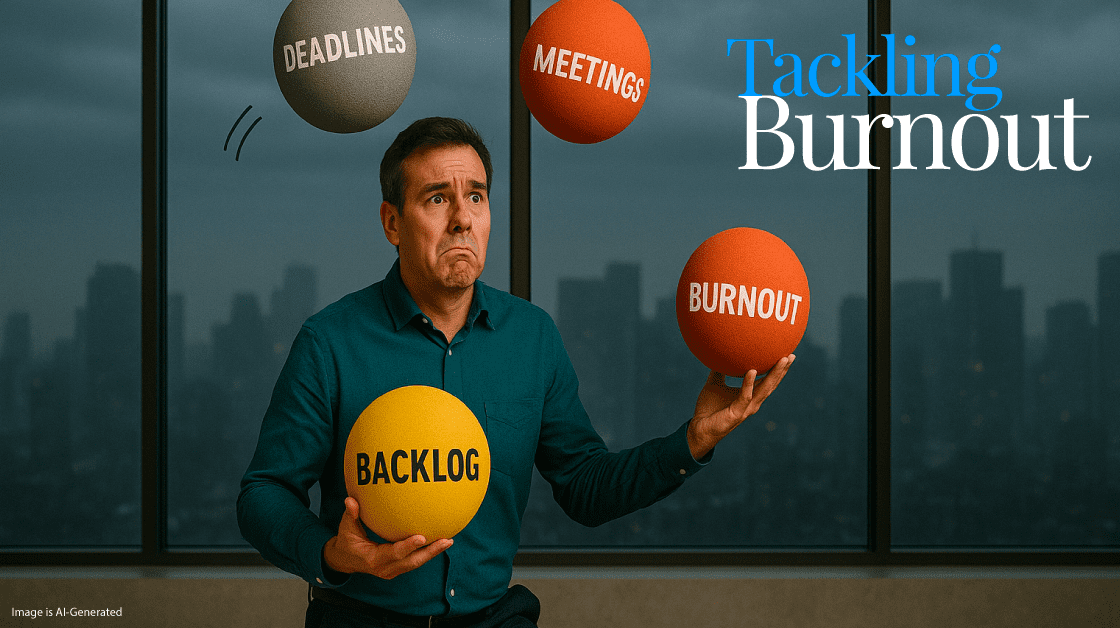
When the Pressure Never Lifts
Some teams operate like they’re always in “go mode.” Deadlines stack. Slack pings multiply. Backlogs grow louder. And eventually, burnout shows up, quietly at first – then all at once. Here’s the thing: your people aren’t the problem. The system is. And that’s where flexible teams – not just staffing, but truly flexible teams as a burnout solution – become a vital part of your resilience strategy.
According to Gallup, 76% of employees experience burnout at least sometimes. For some, it’s episodic. For others, it becomes chronic – a daily undercurrent of fatigue, disengagement, and frustration. And when performance is expected to stay high despite mounting pressure, it’s not just morale that takes a hit – it’s your entire business.
Flexible teams aren’t a trendy perk or a stopgap for talent gaps. They’re a long-term solution to structural overload. When your internal team is working at or near capacity, even a slight uptick in workload – a product launch, a big pitch, or a key teammate’s PTO – can send stress levels through the roof. But with access to flexible talent, you can scale smartly. That doesn’t just protect your team’s time; it protects their trust.
Burnout Isn’t a Weakness. It’s a Warning.
Let’s get one thing straight: burnout doesn’t happen because people don’t care. It happens because they care too much, for too long, without enough support.
Psychologists call this the demand–resource imbalance – where the work exceeds the energy, tools, or time people have to do it. And when crunch time becomes the constant, the burnout cycle accelerates.
Flexible teams offer a reset. Instead of overloading your internal team or rushing a full-time hire you don’t need long-term, you can deploy freelance professionals on demand. Whether it’s a marketing strategist, a UX writer, or a project manager, flexible talent helps your team breathe again – without stalling the work.
That relief isn’t just emotional. It’s operational. Flexible teams shift the equation from reactive scrambling to proactive sustainability – and that’s how flexible teams become a burnout solution you can actually implement.
Companies that consistently leverage flexible resources are better positioned to ride out high-intensity periods without sacrificing mental health. They don’t wait for burnout to spiral. They anticipate it – and they build around it. Think of it as load-balancing, not outsourcing. You’re not removing responsibility; you’re redistributing it more sustainably.
Flexible support also encourages a healthier team mindset. When people know they aren’t going to be left stranded with overwhelming workloads, they approach projects with more confidence, more focus, and more creativity. It’s not about doing less; it’s about doing what matters, and doing it well.
The Case for Bringing in Backup
There’s a common fear that bringing in freelancers signals weakness – like you’re admitting your team can’t handle it. But in reality, flexible staffing is one of the smartest tools available to high-functioning teams. It’s not a shortcut. It’s a strategy.
Rather than overloading your current employees every time demand spikes, you can onboard skilled support precisely when – and where – you need it. Not six weeks from now, not after three rounds of interviews. On demand.
This doesn’t just reduce stress. It enables your internal team to focus on their best work – not the work that’s clogging the pipeline. If you’ve got engineers spending nights formatting documentation, or your Head of Marketing pulling double duty as a project manager, you’re burning daylight… and your team’s fuel.
Flexible support keeps your key players working on high-leverage activities while trusted specialists handle the rest. Your team’s performance improves not because they’re working harder, but because they’re finally working smarter.
Let’s say your marketing team is prepping for a new product launch. Instead of asking them to juggle day-to-day campaigns, trade show prep, and a major brand rollout, you bring in a freelance designer, content writer, and digital strategist. Your internal team directs the strategy; your flexible talent executes with precision. Nobody burns out, and the work gets done faster and better.
When Capacity Isn’t the Only Problem
Workload isn’t the only driver of burnout. Sometimes it’s the feeling of spinning wheels – of working hard without seeing results, or being stuck in execution mode without the right tools or collaborators. This kind of burnout is sneaky. It doesn’t show up in time sheets – it shows up in disengagement, reduced creativity, and “just tell me what to do” energy.
One of the underrated benefits of bringing in flexible talent is the spark it can provide. When you onboard a freelancer who has deep expertise in a particular area – whether it’s UX design, systems automation, or digitall marketing – your team benefits from more than just bandwidth. They get perspective. Innovation. Outside-the-box ideas.
That outside perspective is especially helpful during crunch times, when urgency can cloud clarity. Experienced freelancers can step in, assess the situation quickly, and contribute meaningful value from day one. They’re not there to take over. They’re there to lift the load, tighten the process, and re-energize the team.
Freelancers also often bring cross-industry knowledge that your team may not have. A content strategist who has worked with startups, agencies, and nonprofits may offer campaign insights that you wouldn’t get from someone who’s only seen one kind of environment. That diversity of experience brings more to the table than just execution – it drives innovation.
The Cost of Doing Nothing
Most leaders don’t ignore burnout on purpose – it just sneaks in while they’re busy handling everything else. But the cost of pushing through without support is rarely worth it.
Productivity drops. Absenteeism rises. Employee engagement dips. People burn out, leave, and take institutional knowledge with them. Even those who stay often work at half-capacity, operating in survival mode rather than strategy mode. And then, ironically, the work piles up even more.
In contrast, companies that integrate flexible staffing into their normal operating rhythm aren’t just solving today’s problems – they’re building resilience. They’re protecting their internal teams while staying agile enough to meet shifting demands. Over time, that approach pays dividends: less burnout, better retention, and a reputation as a place where people can do great work – without sacrificing themselves in the process.
It’s not about replacing your team. It’s about protecting them. And when your team feels supported, they don’t just stay longer. They perform better. They contribute more. They actually thrive.
Putting It into Practice
Flexible staffing works best when it’s not treated as a last-ditch effort but as part of your standard playbook – your burnout solution. When crunch time hits, you shouldn’t be scrambling. You should already have relationships in place to get pro-level talent who can plug in quickly and seamlessly.
That’s what separates reactive teams from resilient ones.
Start by identifying your pressure points:
- Where does your team consistently get bottlenecked?
- Which roles are consistently overloaded during launches or high seasons?
- What kind of expertise do you need occasionally but not full-time?
Once you know your needs, you can partner with a talent matching organization to not just tackle burnout, but cut it off at the pass by finding freelancers or consultants who align with your workflows, values, and tools. Ideally, you work with a partner who’s done the vetting for you (ahem, that’s FlexTal); that way, you’re not hiring… you’re activating.
From there, it’s about integrating them well: onboard them thoughtfully, give them access to the right systems, and treat them like part of the team (even if only temporarily). That’s how you get the most value – and how they can do their best work, too.
Burn Bright Without Burning Out
Burn Bright Without Burning Out
Deadlines will always exist. Pressure will come and go. But burnout doesn’t have to be the price your team pays to keep up.
With flexible staffing, you don’t just add hands – you add margin. You create space for your team to focus, breathe, and perform without carrying the weight of three roles. You give your best people a reason to stay. You give your business a way to grow without breaking.
And at the end of the day, isn’t that the goal? A team that performs well and feels well – even when the heat is on. Flexible staffing isn’t a stopgap. It’s how the best teams stay at their best.
Because flexible teams aren’t just a nice-to-have – they’re a burnout solution built for the way modern teams actually work.
FlexTal is the #1 flexible talent matching platform. Every day, we match organizations with pro-level independent contractors for flexible hourly and project-based engagements. Match with the Right Pro, Right Now.



